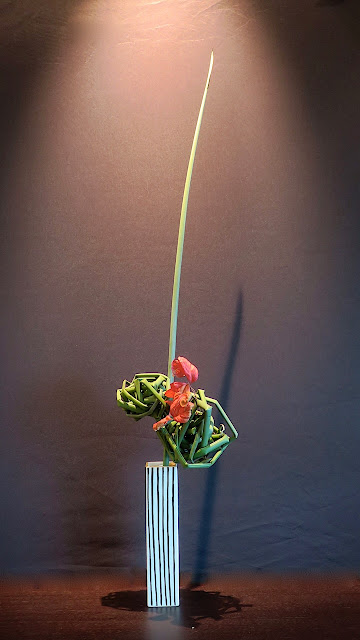At the beginning of last week I presented a demonstration of seven ikebana works to a private group. I was assisted by my fellow Sogetsu teacher Emerald Leung. My student Marta and her husband generously gave me access to their garden to collect some materials, for which I am most grateful. Their house is about 19km inland and, therefore, not subject to the ravages of salty winds. In their sheltered garden, with good soil, many northern hemisphere plants flourish but which would not do well in our seaside garden.
The photos below are not in the order in which I made the arrangements. Unfortunately, I did not photograph the first ikebana I made. It was a "Basic Upright" arrangement, which is the first exercise of the Sogetsu curriculum. Each of the following arrangements is an interpretation of an exercise from the Sogetsu curriculum.
The theme for this arrangement was to use a tsubo-style (globular) vase. The ikebana is horizontally spreading to reveal the beauty of the Japanese Maple Acer palmatum, on the right, and a bare Magnolia branch on the left. A transition from autumn to winter. However, I rather obscured the Magnolia branch by adding some Nandina domestica which has red tips. A green Hydrangea with leaves attached, forms a mass in the middle. On this occasion the maker of the vessel is unknown.
The next ikebana theme was "Showing lines at the base". The lines must be clean and clear where they arise from the vessel. I have used Strelitzia leaves which I partially 'fenestrated" to allow the bright orange Lions tail Leonotis leonurus flowers to peep through from the back. The suiban is by the New Zealand ceramic artist Elena Renka.
The next curriculum exercise was to make a "Composition of Curved lines". I have used Coast Sword Sedge Lepidosperma gladiatum, which has beautiful glossy green leaves that curve particularly well. The contrasting mass is made with two Hydrangea flowers from our garden, which have coloured to a rich red in the cool night air. The unglazed vase is by Don Jones, a South Australian ceramic artist.
This ikebana has the theme of using "Seasonal Plant Materials". In this case the autumnal materials left to right are: Nandina domestica leaves, Hydrangea leaves and a flower, orange Pittosporum P undulatum berries and Medlar Mespilus germanica. The box-shaped ikebana vessel is by the Canadian ceramic artist Leta Cromier
This ikebana is "Focusing on the uses of water". I deliberately chose to arrange the materials underwater for the unique feel such arrangements produce. They are particularly suited to the hot weather of summer. It is important to use a limited amount of material and to attend to the changes in appearance of the material underwater. The materials are: Dietes grandiflora leaves, Ivy Hedera berries, and Cane Begonia flowers.
The theme of my final ikebama was "A composition of Mass and Line". In this case I created two knotted-looking masses using the stems of Strelitzia Juncea. I began by bundling four stems together and then randomly bending them across each other. The mass on the right is rather loose, while that on the left is tighter. The masses have been attached to the vertical line of the same material that arises from the centre of a tall narrow Japanese vase. A small mass of Nandina domestica Nana, leaves have been added to provide a colour focus.
When I came home I reset the line and mass ikebana in a vessel by Phil Elson, I was pleased that this photo shows the space between the top of the vessel and the mass more clearly than the previous photo.
Greetings from Christopher
5th May 2024







No comments:
Post a Comment